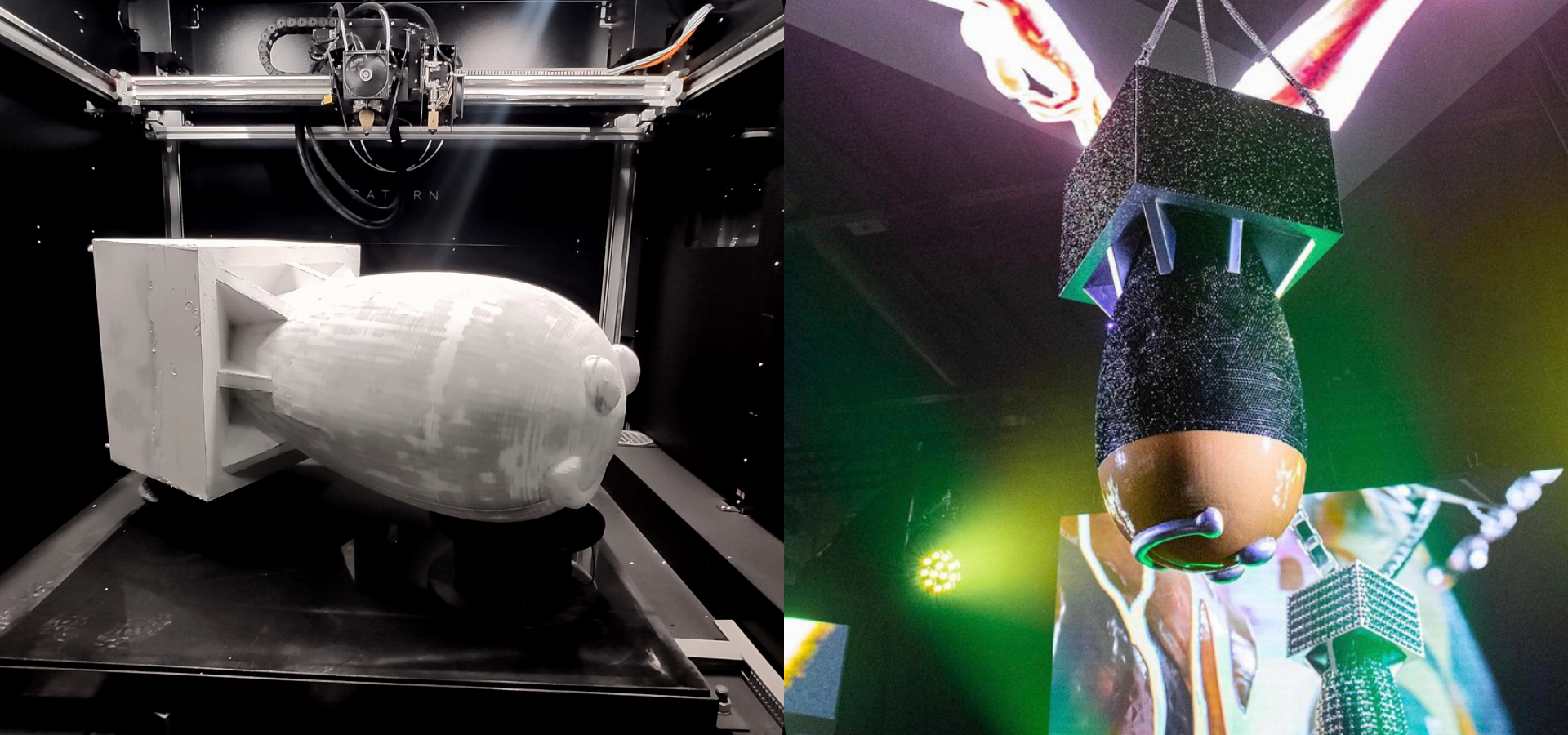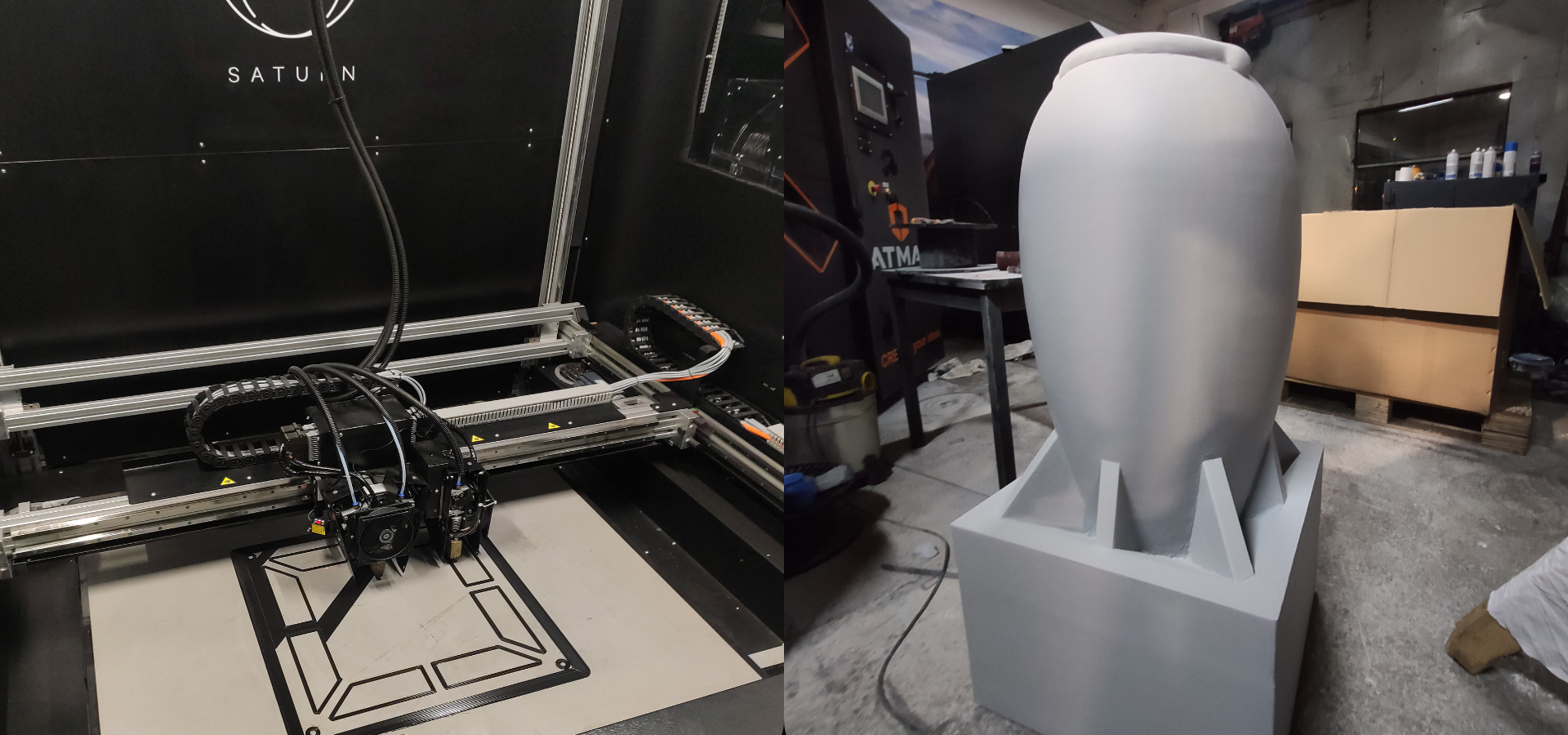3D Warsztat is a company that provides custom 3D printing services. It uses ATMAT 3D printers for additive manufacturing, including a large-scale SATURN 3D printer. One of the latest projects, completed by our partner, was a necklace in the shape of a nuclear bomb, which was scaled to an above-average size.
A few words about the project
The model was used as an element of scenography during the premiere of a necklace from the latest collection of the Customer. The element was previously designed by the client and 3D Warsztat designed additional holes for the rods before printing, which made it possible to suspend it from the ceiling.
The project involved creating a 1200 mm x 575 mm x 575 mm model of the necklace using additive technology, which was the only technology that made it possible to produce such a large model at the lowest possible cost.
 Źródło: 3D Warsztat, DBLK, BROSLO
Źródło: 3D Warsztat, DBLK, BROSLO
Who was our client?

3D Warsztat - is a 3D printing company that also provides scanning, design, reverse engineering, and post-processing services. The company carries out projects of custom elements' manufacturing in a complex way, using its knowledge and many years of experience. It uses, among others, ATMAT standard and large-size printers to realize elements in FDM technology.
3D Warsztat challenge
The project was carried out in two stages. The first part was performed by the 3D Warsztat company, whose goal was to produce a model with a smooth surface. The next step implemented on the Customer's side was to apply lacquer/paint on the surface of the model and cover it with several thousand Swarovski crystals.
3D Warsztat performed the following tasks as part of the project:
- Designing additional holes in the model and preparing the .gcode file for printing.
- Printing the model in two parts on the ATMAT SATURN large-scale 3D printer.
- Preliminary filling of the surface before gluing.
- Connection of two parts with each other using threaded rods.
- Application of putty to all surfaces and careful alignment of joints.
- Smoothing the surfaces after filling - sanding.
- Covering the whole with several layers of primer.
 Źródło: 3D Warsztat
Źródło: 3D Warsztat
3D Warsztat solution
3D Warsztat offered to the customer two options of making the model:
- printing on the ATMAT Galaxy 3D printer with more joining of parts, but with a smooth surface and less post-processing activities.
- printing on an ATMAT Saturn 3D printer in two parts, with more post-processing.
The customer decided on the second variant.
As a result, a bomb model with a smooth surface was created. The model was ready to be covered with paint and hung from the ceiling during the premiere of a new necklace collection.
The model was printed on an ATMAT SATURN large-scale 3D printer using FDM/FFF additive technology. The total time needed to print two elements was three days and all the work connected with smoothing the model and preparing its surface for painting. 40 kg of PLA material was used for printing.
What goals have we achieved?
ATMAT's goal was to produce a large-scale device that would allow for the implementation of unit projects. 3D Warsztat is a perfect example of how the Saturn 3D printer can be used.
As part of an order from an external customer, 3D Warsztat achieved the following results:
- Molding a model solid of a necklace with a size of 1200 mm x 575 mm x 575 mm.
- Producing the model in a way that reduced the time and cost of model realization.
- Adaptation of the model to the client's purpose - the possibility of installing the model under the ceiling.
- Realization of the order according to the guidelines and delivering it to Norway.
What does the customer say about us?
Thanks to the ATMAT Saturn 3D printer, which we have in our machinery park, the project could be efficiently realized. The most important advantage of this device is its main print head. To meet the customer's requirements (the minimum thickness of the sidewall of the model should be 5 mm), we custom-made a special nozzle with a diameter of 2.5 mm. Thanks to it we could realize the order according to the guidelines. The use of a larger nozzle also translated into shorter printing time (when using a layer of 1.25 mm).
Szymon Gamża, Technologist in 3D Warsztat
Partner of the article: 3D Warsztat
Main photo: BROSLO, DBLK
More photos: dblkbergen
